Importance of Customer Experience
SQM Group’s research shows the importance of customer experience to organizations reveals that 71% of contact center senior executives strongly agree that improving a contact center’s customer experience is just as important to the organization as revenue and profitability. As a result, organizations are placing increased importance on customer experience. Customer experience (CX) is defined as a single interaction or the sum of all interactions to resolve a customer’s inquiry or problem. Most SQM clients stated that they have significantly increased their customer experience investment over the last two years. In addition, most contact center senior executives feel that the customer experience investment will continue to increase. In recent years, customer experience investment has been used to improve existing touchpoint First Call Resolution (FCR) and customer service performance, provide a seamless omnichannel experience, and expand touchpoints with increased functionality.
IMPORTANCE OF CUSTOMER EXPERIENCE
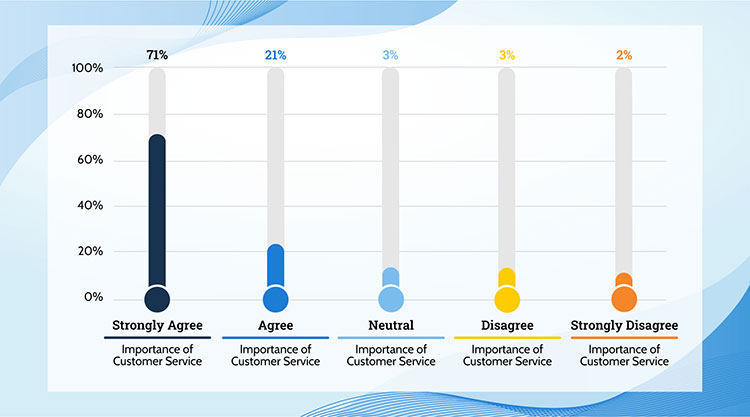
Touchpoint Differentiation
The below graphs shows touchpoints (e.g., call center, chat, email, IVR, website, and retail location) strategy as a source of differentiation. When we ask senior executives the focus of their touchpoint strategies, 76% say it is to improve the existing touchpoints, 60% say it is to integrate the omnichannel customer experience, and 45% say it is to expand the number of touchpoints currently offered. Clearly, the priority is to improve individual touchpoints’ FCR performance, and SQM is in complete agreement. In addition, 57% of senior executives either agree or strongly agree that their touchpoint strategy is a source of differentiation from the competition. However, based on SQM’s research, the source of differentiation that senior management claims are overinflated. Moreover, our view is that touchpoint customer service differentiation is closer to 5% for organizations.
Furthermore, touchpoint expansion is not a source of differentiation because competition will offer new touchpoints if they do not already, and customers will expect those touchpoints to be delivered anyways. Furthermore, when a customer uses a touchpoint, in most cases, they use multiple touchpoints to resolve an inquiry or problem. For example, when using the call center, a customer uses the IVR and agent touchpoints and uses chat and email for the website. The call center touchpoint is the channel of choice for customers when the interaction is complex, and the self-service touchpoints are the channel of choice for simpler interactions.
Offering an omnichannel (e.g., seamless experience for resolving an inquiry or problem) CX can be a source of differentiation for those customers using multiple touchpoints. However, the real opportunity for a source of differentiation is with the individual touchpoints. Only 5% of SQM’s clients provide world-class FCR performance for their main touchpoints (e.g., call center and website). Customers want their inquiry or problem to be resolved on the first contact using only one touchpoint. SQM Group’s research shows 93% of customers using the call center touchpoint and 72% of customers using the website touchpoint expect to be able to resolve their inquiry or problem in one contact.
STRATEGY AS A SOURCE OF DIFFERENTIATION
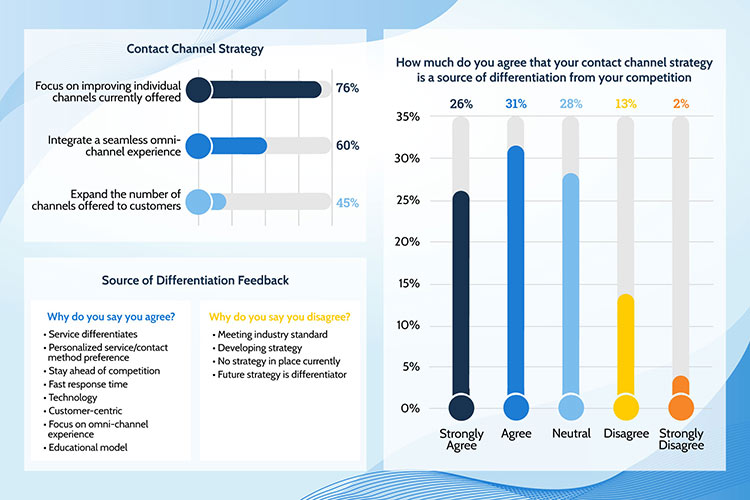
Priorities for Achieving Customer Experience
The below figure shows the organization’s priority for achieving its customer experience strategy. Measuring Csat is the number one priority. In the last few years, organizations have focused on adding new touchpoints and realized that self-service touchpoints for resolving inquiries need to be improved. Again, SQM believes that improving self-service touchpoints for resolving interactions should be at the top of the priority list for most organizations. Contact centers have ownership of up to six or more channels and, as a result, have been focused on aligning people, processes, and technology practices to support those touchpoints.
PRIORITIES FOR ACHIEVING CUSTOMER EXPERIENCE STRATEGY
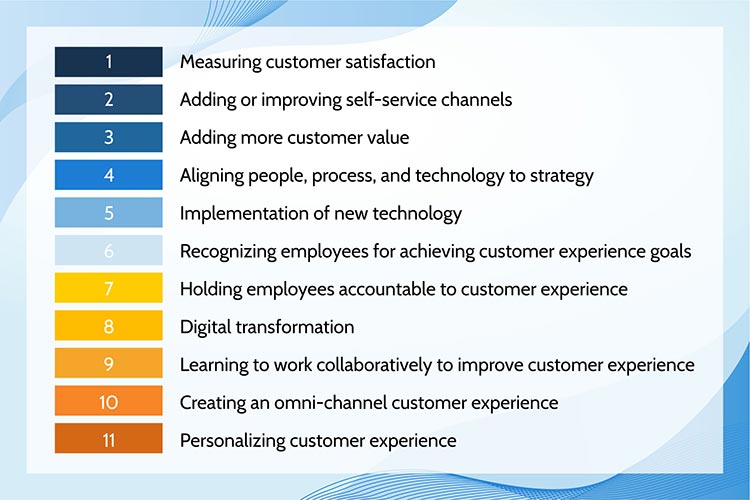
Measures of Success for Touchpoints
The below figure shows the measures of success for touchpoint customer experience. The top four measures of success for the customer experience strategy are FCR, enterprise-wide Csat, channel Csat, and retention. SQM is in complete agreement, with these metrics being the top measures of success. It is essential to state that FCR and Csat differ significantly by touchpoint. For example, the email touchpoint Csat is typically 10% to 20% top box response rating lower than the call center Csat top box response rating. SQM does not have a client that we benchmark who is performing at the same performance level for every touchpoint. In most cases, the measures of success are based on the post-contact surveying method to determine customer experience.
MEASURES OF SUCCESS FOR TOUCHPOINT CUSTOMER EXPERIENCE
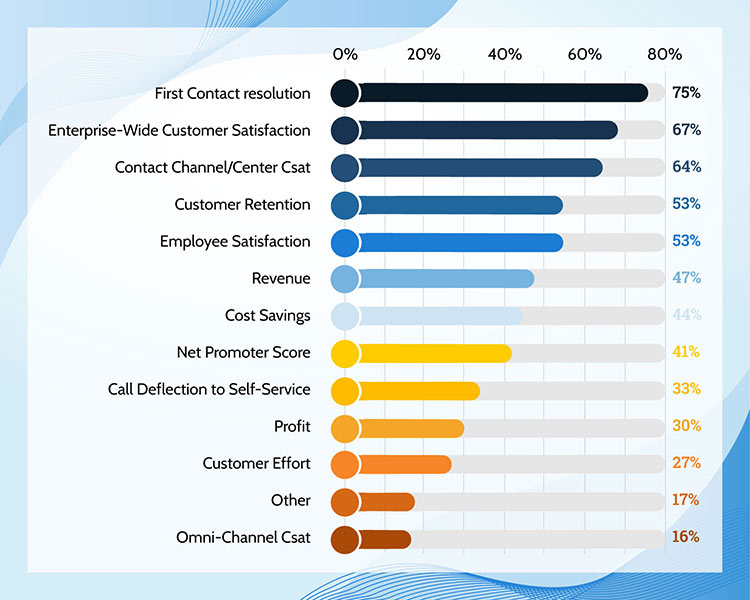
The below figure shows the execution of customer experience operating practices. Again, SQM has less than 5% of clients who can achieve 80% or higher for FCR and 85% or higher for Csat (top box response) customer experience for resolving an inquiry or problem on the core contact channels. The good news is that C-level executives are highly committed to improving customer experience. The four areas where organizations are performing poorly with their execution of their customer experience operating practices are the following:
- Using big data to improve customer experience
- Having the right technology to achieve customer experience goals
- Holding employees accountable to customer experience
- Having the budget available to achieve customer experience goals
EXECUTION OF CUSTOMER EXPERIENCE OPERATING PRACTICES
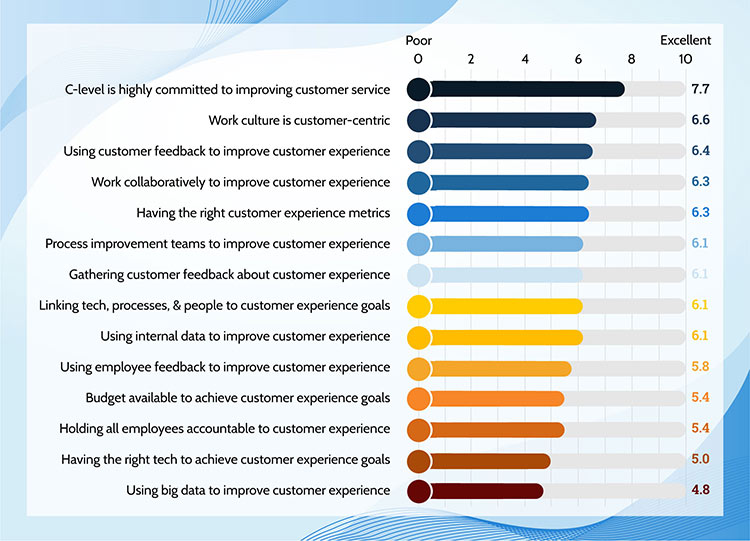
It has been SQM’s experience that having the right technology, holding all employees accountable, and having the proper budget is essential for providing are critical for delivering great customer service using a touchpoint. However, while many organizations may feel that using big data is vital for improving customer experience, SQM has observed only a few clients who have successfully improved customer experience by using big data. SQM would argue that post-contact survey feedback has had a much more proven track record than big data for improving customer experience.
Quick Related Links
First Call Resolution Definition First Call Resolution PPT First Call Resolution Benefits First Call Resolution Strategies First Call Resolution Operating Philosophy FCR Case Study Survey Data Calculate First Call Resolution CX Pulse Check VoC Closed Loop Top 10 CX Metrics FCR Strategy Options Outside-In or Inside-Out Customer Journey Mapping
